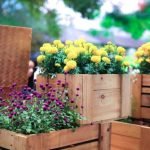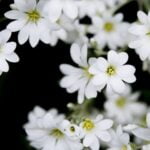Are you looking for creative gardening ideas for small spaces? Whether you have a tiny balcony, a compact patio, or just a limited amount of yard space, there are plenty of ways to turn your little outdoor oasis into a lush and vibrant garden. In this article, we will explore various innovative techniques and strategies for gardening in small spaces, from container gardening to vertical gardening and beyond.
Gardening in small spaces offers numerous benefits, including the opportunity to maximize every inch of available space and the chance to enjoy the beauty of nature even in confined areas. By utilizing creative gardening ideas tailored for small spaces, you can create a beautiful and functional garden that adds charm and personality to your home while also providing you with fresh herbs, flowers or even vegetables.
From utilizing pots and planters to making the most out of vertical space and exploring micro gardening techniques, there are endless possibilities for creating a thriving garden in a limited space. Whether indoors or outdoors, small gardens can be just as impressive as larger ones with the right approaches. So let’s dive into the world of creative gardening for small spaces and discover how you can transform your compact area into a green paradise.
Container Gardening
When it comes to creative gardening ideas for small spaces, container gardening is a popular and practical option. Whether you have a tiny balcony, a small patio, or even just a windowsill, using pots, planters, and containers can help maximize your gardening space. This method not only allows for flexibility in moving the plants around but also provides the opportunity to grow a variety of flowers, herbs, or vegetables.
Choosing the right containers is crucial for successful small space gardening. For instance, shallow-rooted plants like lettuce and herbs can thrive in smaller pots, while deep-rooted vegetables like tomatoes and peppers require larger containers. Additionally, considering the material of the containers is important as it can affect moisture retention and temperature regulation for the plants. Tending to container gardens may involve regular watering and adequate sunlight exposure to ensure healthy growth.
Creative Plant Pairings
Incorporating creative plant pairings within container gardening is another way to make the most out of limited space. For example, planting climbing vegetables like beans with compact crops such as radishes can optimize both vertical and horizontal space utilization.
Mixing different types of plants with varying heights and foliage textures can add visual interest to your small garden while also maximizing its productivity. With some research and planning, you can create an aesthetically pleasing and productive garden no matter how constrained your outdoor space may be.
Repurposing Household Items
An additional approach to container gardening is repurposing household items into plant containers. From old mason jars for growing sprouts on the kitchen counter to creatively upcycled wooden crates for patio herb gardens, there are plenty of opportunities to think outside the box when it comes to utilizing available resources for small space gardening. Not only does this approach minimize costs, but it also allows for customization based on personal style preferences while contributing to sustainable living practices.
By exploring different approaches within container gardening such as creative plant pairings and repurposing household items as planters, individuals with limited outdoor space can still enjoy a flourishing garden filled with their favorite flora or homegrown produce. With some careful planning and creativity in selecting suitable containers for various plants, anyone can discover the joy of cultivating their own green oasis in any size living environment.
Vertical Gardening
When space is limited, it’s time to start thinking vertically. Vertical gardening is a fantastic way to maximize the growing area in small spaces, and it also adds an interesting visual element to your garden. Here are some creative gardening ideas for small spaces using vertical gardening techniques:
- Utilizing trellises and arbors: These structures provide support for climbing plants such as peas, beans, cucumbers, and even certain types of tomatoes. By encouraging these plants to grow upwards rather than spreading out horizontally, you can make the most out of your limited space.
- Wall-mounted planters: Hanging pots or wall-mounted planters are perfect for growing herbs, flowers, or even small vegetables in a vertical fashion. This not only saves space but also adds a decorative touch to your garden walls or fences.
- Hanging baskets: Whether suspended from a pergola, balcony railing, or shepherd’s hook, hanging baskets are another great way to add greenery without taking up valuable ground space. They can be planted with trailing flowers or vines that will spill over the sides and create a lush display.
By incorporating these vertical gardening ideas into your small space garden, you’ll be able to enjoy an abundance of plant life without sacrificing precious square footage.
Indoor Gardening
Incorporating an indoor garden is one of the most creative gardening ideas for small spaces. Whether you live in an apartment, a condo, or a house with limited outdoor space, bringing greenery indoors can liven up your living space and provide a sense of tranquility. Here are some tips for maintaining an indoor garden in small spaces:
- Choose the right plants: Not all plants thrive indoors, especially in limited sunlight. Opt for low-maintenance houseplants like pothos, snake plants, or spider plants that can thrive in low light conditions. For herbs, consider growing basil, mint, or chives near a sunny window.
- Utilize vertical space: Just like in outdoor gardening, maximizing vertical space is crucial for indoor gardening. Install wall-mounted planters or hanging shelves to free up valuable floor space while adding visual interest to your living area.
- Maintain proper care: Indoor plants require regular watering and occasional pruning to stay healthy. Be sure to check the specific care requirements for each plant you choose and create a regular schedule for maintenance.
Additionally, consider investing in self-watering pots or planters with built-in drainage systems to make your indoor garden more manageable and sustainable. With these tips, you can successfully create an indoor oasis even in the smallest of living spaces.
Micro Gardening
When it comes to gardening in small spaces, micro gardening is a game-changer. This technique involves growing vegetables, herbs, and flowers in small containers, making the most out of limited space for growing produce. One popular method of micro gardening is using raised beds or planter boxes, which can be easily placed on patios, balconies, or even windowsills.
There are numerous creative gardening ideas for small spaces when it comes to micro gardening. For example, utilizing vertical space with tiered planters or hanging baskets allows for the growth of multiple plants without taking up valuable ground space. Additionally, choosing compact varieties of plants and using companion planting techniques can maximize the yield from even the smallest of gardens.
In terms of productivity, micro gardening has been shown to be highly efficient. When properly managed, these smaller gardens can produce a surprising amount of fresh produce and herbs. In fact, according to the University of California Cooperative Extension Master Gardener Program in Sonoma County, when using square foot gardening techniques (another space-saving method), small garden spaces can yield high quantities of vegetables in just a single square foot.
| Micro Gardening Benefits | Key Micro Gardening Techniques |
|---|---|
| Maximizes limited garden space | Utilizing vertical planting with tiered planters |
| Produces a surprising amount of fresh produce | Raised beds and planter boxes for small container gardens |
| Makes use of compact plant varieties and companion planting | Square foot gardening for high vegetable yields |
Creative Hardscaping
Incorporating hardscaping elements into small gardens can provide structure, visual interest, and functionality. This is especially important in small spaces where every element of the garden needs to serve a purpose. Hardscaping features like pathways, small ponds, and seating areas can help maximize the use of space, creating different zones within the garden for various activities such as relaxation or entertaining. Additionally, these elements can also add texture and visual appeal to the garden, making it more aesthetically pleasing.
When implementing hardscaping in a small garden, it’s essential to carefully plan and consider the scale of each element. For example, using smaller-scale paving materials and compact furniture can help prevent these features from overwhelming the limited space available. It’s also crucial to strike a balance between hardscape and softscape elements by incorporating plants and greenery to create a harmonious and inviting outdoor space.
One creative idea for small spaces is to use multi-functional hardscape features. For instance, a built-in bench with storage underneath or an arbor that doubles as a trellis for climbing plants can save space while serving multiple purposes. These innovative hardscaping solutions not only maximize the functionality of the garden but also contribute to its overall design aesthetic.
| Element | Importance |
|---|---|
| Hardscaping | Provides structure, visual interest, and functionality |
| Scale Consideration | Choosing smaller-scale materials and furniture to avoid overwhelming limited space |
| Multi-Functional Features | Built-in benches with storage or arbors doubling as trellises as space-saving options |
Space-Saving Techniques
When it comes to gardening in small spaces, every inch counts. Utilizing space-saving techniques can help maximize the potential of limited space and create a productive and beautiful garden. One popular technique for small space gardening is square foot gardening, which involves dividing the growing area into small square sections to efficiently grow a variety of plants. This method not only saves space but also helps with organization and easy maintenance.
Another space-saving technique is intercropping, which involves planting different types of crops in the same area. By selecting plants that complement each other in terms of growth habits and nutrient needs, gardeners can make the most out of their limited space while promoting biodiversity. For example, planting tall crops like corn alongside shorter ones like beans can optimize vertical space and increase overall yield.
In addition to these techniques, utilizing vertical space through trellises, wall-mounted planters, and hanging baskets can significantly expand the available gardening area. This approach is especially beneficial for those with small balconies or patios. By incorporating these various space-saving techniques, gardeners can optimize their limited space for a bountiful harvest and a visually stunning garden.
Incorporating these creative gardening ideas for small spaces not only makes efficient use of limited areas but also adds aesthetic appeal to urban environments where outdoor space may be scarce. With the right planning and design elements, even the smallest of spaces can be transformed into flourishing gardens that provide joy, beauty, and an abundance of homegrown produce.
Design and Aesthetics
When it comes to gardening in small spaces, the design and aesthetics of the garden play a crucial role in creating a visually appealing and functional outdoor space. Whether you have a tiny balcony, a small patio, or even just a corner of your backyard, there are plenty of creative gardening ideas for small spaces that can help transform your area into a beautiful oasis.
Design Elements
Incorporating design elements such as color, texture, and scale can make a big impact in a small garden. Choosing plants with varying heights and foliage can add visual interest and create the illusion of depth in a limited space. Utilizing different colors and textures can also enhance the overall aesthetic of the garden, making it feel more vibrant and dynamic.
Functional Garden Layout
In small spaces, it’s important to prioritize functionality while still maintaining an attractive design. Careful planning is essential to ensure that every inch of space is utilized effectively. This may involve strategically placing containers or vertical structures to maximize growing space without overcrowding the area.
Creating Focal Points
Focal points can draw the eye and add interest to a small garden. Whether it’s a unique plant arrangement, an art piece, or a decorative element like a small fountain or sculpture, incorporating focal points can elevate the overall design of the space.
By implementing these design principles and integrating creative gardening ideas for small spaces, such as clever container arrangements or vertical gardens, it’s possible to create an inviting and visually stunning garden regardless of size limitations. With careful thought put into the layout and aesthetics, even the smallest outdoor space can be transformed into a lush green haven.
Conclusion
In conclusion, gardening in small spaces does not have to be a limiting experience. By utilizing creative gardening ideas for small spaces such as container gardening, vertical gardening, indoor gardening, micro gardening, creative hardscaping, space-saving techniques, and focusing on design and aesthetics, individuals can transform even the tiniest of areas into flourishing green spaces.
The benefits of incorporating these creative ideas are not only limited to the visual appeal of the garden but also extend to the environmental impacts and personal satisfaction. Not only do these methods allow individuals to grow their own produce and herbs no matter how much space they have available, but they also contribute to purifying the air and improving overall well-being.
Additionally, being able to create an aesthetically pleasing garden in a limited space can provide a sense of accomplishment and pride.
Overall, I encourage readers to embrace these creative gardening ideas for small spaces and put them into practice. Whether it’s utilizing vertical space with trellises and hanging baskets or implementing space-saving techniques like square foot gardening and intercropping, there are countless possibilities for transforming small areas into beautiful gardens. With creativity, dedication, and a love for nature, anyone can enjoy the rewards of tending to their own little slice of greenery.
Frequently Asked Questions
What Grows Well in a Small Space?
In a small space, you can grow herbs, lettuces, cherry tomatoes, peppers, and even dwarf fruit trees like lemons or figs. These plants are well-suited for containers and don’t require a lot of space to thrive.
How Do You Make a Small Garden Nice?
To make a small garden nice, focus on organization and aesthetics. Use vertical space with trellises or hanging planters, add colorful flowers for visual interest, create defined pathways, and incorporate lighting for ambiance.
How Do I Maximize My Small Garden Space?
Maximizing your small garden space involves careful planning and strategic placement of plants. Utilize raised beds or tiered planters to increase planting area, grow vertically with climbing plants or trellises, and consider multi-functional furniture that can also serve as planters.

Welcome to my gardening blog! I am passionate about plants and enjoy sharing my knowledge and experiences with others. In this blog, I will write about everything related to gardening, from tips on how to get started to updates on my own garden projects.





